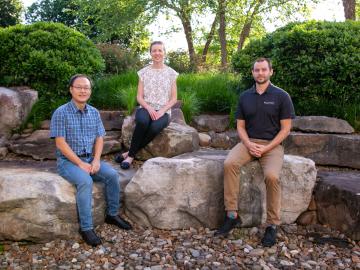
Filter News
Area of Research
- (-) Materials (43)
- (-) Supercomputing (39)
- Advanced Manufacturing (2)
- Biology and Environment (52)
- Biology and Soft Matter (1)
- Building Technologies (2)
- Clean Energy (49)
- Computational Biology (1)
- Computer Science (1)
- Electricity and Smart Grid (1)
- Functional Materials for Energy (2)
- Fusion and Fission (15)
- Isotopes (3)
- Materials for Computing (6)
- National Security (25)
- Neutron Science (14)
- Renewable Energy (1)
News Topics
- 3-D Printing/Advanced Manufacturing (5)
- Advanced Reactors (1)
- Artificial Intelligence (9)
- Big Data (3)
- Bioenergy (5)
- Biology (7)
- Biomedical (5)
- Buildings (4)
- Chemical Sciences (11)
- Clean Water (1)
- Climate Change (4)
- Composites (2)
- Computer Science (11)
- Coronavirus (5)
- Critical Materials (4)
- Cybersecurity (1)
- Decarbonization (4)
- Energy Storage (14)
- Environment (6)
- Exascale Computing (6)
- Frontier (7)
- Fusion (1)
- Grid (3)
- High-Performance Computing (10)
- Isotopes (2)
- Machine Learning (5)
- Materials (28)
- Materials Science (11)
- Microscopy (5)
- Nanotechnology (7)
- National Security (3)
- Neutron Science (5)
- Nuclear Energy (1)
- Partnerships (4)
- Physics (6)
- Polymers (3)
- Quantum Computing (7)
- Quantum Science (6)
- Security (2)
- Simulation (5)
- Space Exploration (1)
- Summit (7)
- Sustainable Energy (3)
- Transformational Challenge Reactor (1)
- Transportation (2)
Media Contacts

Oak Ridge National Laboratory’s Innovation Crossroads program welcomes six new science and technology innovators from across the United States to the sixth cohort.

To solve a long-standing puzzle about how long a neutron can “live” outside an atomic nucleus, physicists entertained a wild but testable theory positing the existence of a right-handed version of our left-handed universe.

ORNL researchers have developed an upcycling approach that adds value to discarded plastics for reuse in additive manufacturing, or 3D printing.

Doug Kothe has been named associate laboratory director for the Computing and Computational Sciences Directorate at ORNL, effective June 6.

The Department of Energy’s Office of Science has selected three Oak Ridge National Laboratory scientists for Early Career Research Program awards.

To optimize biomaterials for reliable, cost-effective paper production, building construction, and biofuel development, researchers often study the structure of plant cells using techniques such as freezing plant samples or placing them in a vacuum.

Jagjit Nanda, a distinguished staff scientist, has been elected a fellow of the Materials Research Society. The lifetime appointment recognizes outstanding members whose sustained and distinguished contributions to the advancement of materials research are internationally recognized.

Two decades in the making, a new flagship facility for nuclear physics opened on May 2, and scientists from the Department of Energy’s Oak Ridge National Laboratory have a hand in 10 of its first 34 experiments.

Researchers at Oak Ridge National Laboratory are using state-of-the-art methods to shed light on chemical separations needed to recover rare-earth elements and secure critical materials for clean energy technologies.

New polymer materials under development at Oak Ridge National Laboratory could enable safer, more stable batteries needed for electric vehicles and grid energy storage.


